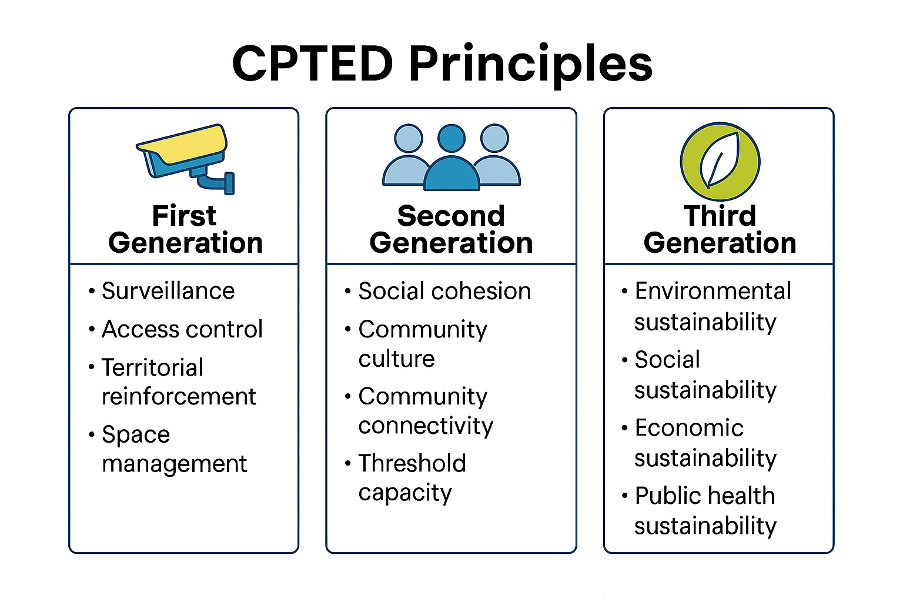Evolution of CPTED
The concept of Crime Prevention Through Environmental Design (CPTED) was introduced in the United States around 1960, with the official term ‘CPTED’ being coined by criminologist C. Ray Jeffery in 1971 (Jeffery, 1971). CPTED emerged when architects and criminologists realised the built environment influences crime. It was driven by architects, criminologists, and planners working together. Formed in 1996, the International CPTED Association (ICA) was established to share global research, best practice, and standards. They continue to promote global knowledge sharing aimed at created safer communities and environments through their ICA newsletter (The International CPTED Association (ICA) - A Brief History of the ICA, n.d.).
CPTED in NSW
CPTED was officially recognised in NSW in 2001. It was incorporated into the planning system through the introduction of the Crime Prevention Legislative Guidelines under Section 4.15 of the Environmental Planning and Assessment Act, 1979 (Safer By Design - NSW Police Public Site, n.d.).
Crime Prevention Legislative Guidelines guide councils in assessing new developments. Developers must integrate safety/security into designs upfront, not as an afterthought. It is important for councils to consider CPTED to ensure safety becomes part of how we build communities. Its objective is to design safer, more liveable spaces from the start. It encourages proactive risk mitigation rather than reactive policing. Developers should refer to the relevant Development Control Plan (DCP) or check with their local council or planning authority for exact requirements for their development application.
ISO Standards
The two main ISO standards referenced in CPTED reports are:
ISO 22341:2021 à Security and resilience - Protective security - Guidelines for crime prevention through environmental design (ISO 22341, n.d.).
- Provides broad global guidelines for CPTED.
- Provides structured framework for organisations & governments.
- Covers physical, social, and technological aspects of safety.
ISO 22341-2:2025 à Security and resilience - Protective security - Part 2: Guidelines for crime prevention through environmental design for residential facilities (ISO 22341-2, n.d.).
- Is tailored for residential facilities.
- Encourages consistency in design and assessment worldwide.
- Aligns CPTED with resilience and protective security strategies.
So, what is CPTED?
CPTED is not just about video surveillance it is a process grounded in risk management applied to design. The goal of CPTED is to reduce opportunities for crime, increase natural guardianship. Environmental design can prevent or reduce opportunities for crime. CPTED can be split into three generations:

Figure 1. CPTED Principles.
First Generation Principles - focuses on basic design elements for safety and prioritised physical security and environmental controls.
- Surveillance
- Access control
- Territorial reinforcement
- Space management
Second Generation Principles - focuses on incorporating social and community aspects to enhance crime prevention.
- Social cohesion
- Community culture
- Community connectivity
- Threshold capacity
Third Generation Principles - focuses on sustainability such as green environmental design strategies and the perception of urban spaces.
- Environmental sustainability
- Social sustainability
- Economic sustainability
- Public health sustainability
What are the problems and challenged surrounding CPTED?
Many reports reuse CPTED reports, changing only the location. Not many CPTED reports use crime statistics and if they do, the data is too broad. Only 49% of reports use crime statistics that are often too broad when used. Only 33% include population or community data (Clancey et al., 2011).
This results in CPTED reports becoming ineffective as they fail to account for the unique characteristics and circumstances presented by each site. Every community has its own crime patterns, demographic makeup, and social dynamics, which should be reflected in a thorough CPTED analysis. Ultimately, these shortcomings can lead to wasted resources, reduced trust in CPTED processes, and missed opportunities for meaningful crime prevention. Comprehensive, site specific analysis using detailed crime statistics and community data is essential for developing targeted, effective, and sustainable CPTED strategies.
What does Lote do differently?
Here at Lote, we take a comprehensive risk-based approach to CPTED reports. We analyse the local crime statistics around the area which impact our mitigation measures. We conduct a comprehensive review of local crime statistics to uncover trends, recurring incidents, and emerging risks in the vicinity of the site. Additionally, we use crime mapping tools to identify the types and timings of offenses most prevalent in the area. Targeted strategies can be developed to effectively address and mitigate these risks. Our CPTED analysis is an evaluation of the environment to provide recommendations that discourage criminal behaviour. We also recommend measures such as improved lighting, strategic landscaping to enhance visibility, access control features, and signage. The overall goal of the CPTED analysis is to make criminal activity more difficult to conduct, and to increase the perceived risk for potential offenders.
We also utilise the NSW Police CPTED Checklist within our reports to ensure compliance. It is used as a benchmark for evaluating safety and security measures, ensuring that all aspects of the site meet or exceed quality assurance requirements. It covers aspects like territorial reinforcement, surveillance opportunities and maintenance practices providing guidelines for various areas.
Another differentiator of Lote is that we evaluate and markup architectural plans in conjunction with our report. This helps us identify potential vulnerabilities, such as blind spots or ambiguous entry points within the site. We analyse the plans to propose design modifications that enhance safety. This allows us to make recommendations such as securing entry points using an access control system, video surveillance and lighting to monitor blind spots and entry points, and implementation of bollards in areas of high pedestrian activity.
Role of AI in the practical implementation of CPTED
With AI being on the rise, this impacts the practical implementation of CPTED. AI powered surveillance can be used to analyse data from cameras, social media, and other sources to predict crime hotspots. AI modelling can help planners design safer public spaces. It can be helpful to simulate crowds, identifies blind spots pre-construction, support evidence-based planning at masterplan level and help optimise placement of resources like cameras and lighting (Hamedi, 2025).
Conclusion
In summary, the effectiveness of CPTED hinges on thorough, site-specific analysis that leverages detailed crime statistics and community insights. While traditional approaches often fall short due to broad, generic reporting, Lote’s risk-based methodology ensures tailored recommendations and robust compliance with best-practice standards. The integration of architectural plan reviews and crime statistical analysis further enhances our capacity to identify vulnerabilities and optimise crime prevention strategies. By adopting these comprehensive and forward-thinking practices, CPTED can deliver safer, more resilient environments that genuinely reflect the needs and characteristics of each community.
References
- Clancey, G., Fisher, D., & Lee, M. (2011). Do Crime Risk Assessment Reports Measure Crime Risks? Current Issues in Criminal Justice, 23(2), 235–254. https://doi.org/10.1080/10345329.2011.12035920
- Hamedi, K. (2025, March 3). AI and CPTED: Transforming urban crime prevention. Meer. https://www.meer.com/en/83845-ai-and-cpted-transforming-urban-crime-prevention
- ISO 22341-2:2025. (n.d.). ISO. Retrieved August 19, 2025, from https://www.iso.org/standard/50081.html
- ISO 22341:2021. (n.d.). ISO. Retrieved May 23, 2025, from https://www.iso.org/standard/50078.html
- Jeffery, C. R. (1971). Crime Prevention Through Environmental Design. American Behavioral Scientist, 14(4), 598. https://doi.org/10.1177/000276427101400409
- Safer By Design—NSW Police Public Site. (n.d.). Retrieved August 19, 2025, from https://www.police.nsw.gov.au/safety_and_prevention/policing_in_the_community/safer_by_design
- The International CPTED Association (ICA)—A Brief History of the ICA. (n.d.). Retrieved August 19, 2025, from https://www.cpted.net/A-brief-history

